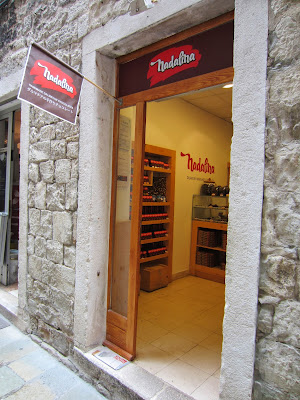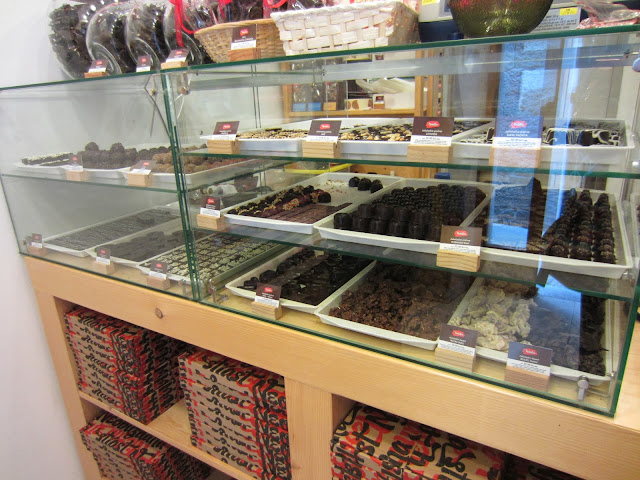Diocletian's Palace, the walled section of the city of Split, is an intricate maze of narrow alleys that can either be excessively crowded or eerily quiet.
While definitely a tourist city, it is also a very lived-in place, and the blending of tourist/resident, exotic/utilitarian, and ancient/modern makes it very charming.
It's not unusual to run across "minor" palaces within the palace while strolling through Split. For example, the one below is the Augubio Palace, and while it doesn't look that palatial to me, it was built for an important noble in the late 15th century and was at one time a very fine residence. Now it is a five star hotel with rooms that rent for $350 to $400 a night.
A must-see in Split is the extensive labarinthine caverns that make up Diocletian's cellar. An entrance at the sea enabled ships to unload their wares directly into these cellars, keeping Diocletian and his successors well-stocked with food, wine, and other essentials. Some sources say that slaves were also housed in these quarters. Over the centuries, the cellars stopped being used for storage and started being used for sewage. Excavation and renovation began in the 1850s, and now the cellars can be toured for a small entrance fee paid after passing through a series of rooms housing the typical tacky tourist stalls:
A map on one of the walls shows the vast expanse of his empire:
Whew. Just when I thought I'd have to go back upstairs:
No PVC pipe back in those days. It must have been incredibly laborious to carve these pipes out of stone:
There are occasional connections to the outdoors, making for exceptional ventilation and, as already noted, uneven lighting:
Naturally, walking around in the cellar made us hungry and thirsty. After we made our exit, we started looking for food and drink.
I didn't need Google Translate to know that these pastries were going to be spectacular, and they were!
Bob and I are big fans of Schweppes Bitter Lemon, and Croatia has their own version, so we did a taste test. Sorry, Pipi, but you don't even come close.
While definitely a tourist city, it is also a very lived-in place, and the blending of tourist/resident, exotic/utilitarian, and ancient/modern makes it very charming.
It's not unusual to run across "minor" palaces within the palace while strolling through Split. For example, the one below is the Augubio Palace, and while it doesn't look that palatial to me, it was built for an important noble in the late 15th century and was at one time a very fine residence. Now it is a five star hotel with rooms that rent for $350 to $400 a night.
Stout pillars support the roof and provide a firm foundation for apartments built above:
Layers upon layers of thin bricks at the top of the columns shows fine craftsmanship and impressive engineering:
Like a gopher's burrow, the bewildering network of columns, rooms, doors, and hallways, the uneven lighting, and the echoing acoustics would make this cellar the perfect place for a scary game of hike-and-seek. When I think about how my brother used to jump out from behind things to scare me when I was little, I know I never want to visit these caverns with him.
The rough, rocky vaulted ceilings in some of the rooms create a tomb-like atmosophere:
A bust of stern Diocletian peers out at his cellar. Perhaps he is wondering who all the people are and what they have done with his supplies.A map on one of the walls shows the vast expanse of his empire:
Whew. Just when I thought I'd have to go back upstairs:
There are occasional connections to the outdoors, making for exceptional ventilation and, as already noted, uneven lighting:
This would be a superb movie location. I wonder how long it will be until some Hollywood horror flick is filmed here? It would be perfect for a Hitchcock movie.
Naturally, walking around in the cellar made us hungry and thirsty. After we made our exit, we started looking for food and drink.
Aha! Something we recognize!
Hmmm, but what are those unfamiliar words on the labels? At the top of each label are the words Je za tebe! which Google Translate tells me means "It is you!" Apparently you are supposed to choose the one you most identify with. Brat means "brother"? Yeah, that makes sense! |
| Frend = friend; Dragan = sweetheart; Brat = brother; Ijepotica = beauty |
 |
| Partijaner = party lover; Frajer = guy |
Bob and I are big fans of Schweppes Bitter Lemon, and Croatia has their own version, so we did a taste test. Sorry, Pipi, but you don't even come close.
Near the southern sea gate we ran across Nadalina Chocolate Shop. Actually, I think my homing device drew us there. I have a sixth sense for chocolate shops.
I've since learned that this shop was started in the 1990s by a famous Croatian punk rocker who had a passion for fine chocolate. The chocolates made here can be purchased at other deli chains in Croatia, but the pralines are unique to this store. They can't be transported because of their delicate nature. Had I known that, I would have bought several pounds to test that assertion. I'm sure I would have discovered it to be true and would have had to consume them all post haste. Alas, I was unaware, and settled for their other (still incredible) chocolates. If someone goes there, please report back on your assessment of the pralines, okay?
Ah, Split--such a fun, eclectic spot!
Next: One last post from OUTSIDE Split's palace walls.


































One of the things I love about your travel eye is the common touch: the laundry hanging from the window, the plastic elf standing on a step, the Coke bottles with individual phrases on them, the contrast between choked halls and empty halls. Nice.
ReplyDeleteI wonder if the Coke bottles will still be there, or if that was a summer promotion. I'll check on those pralines for you! Those underground caverns have been added to The List of Sights to See. Fabuloso!
ReplyDelete